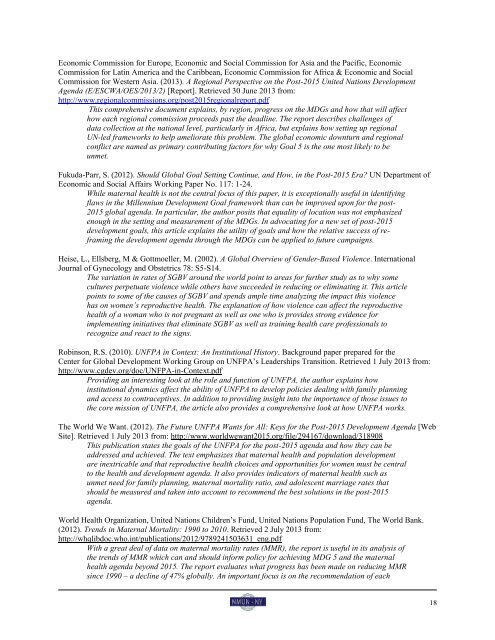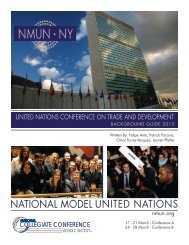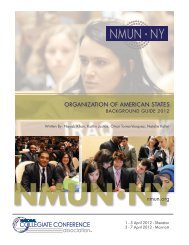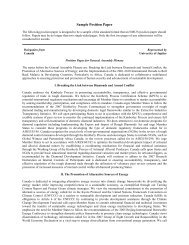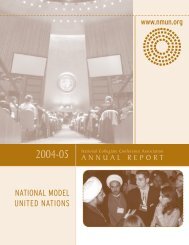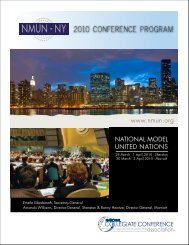UNFPA Background Guide - National Model United Nations
UNFPA Background Guide - National Model United Nations
UNFPA Background Guide - National Model United Nations
Create successful ePaper yourself
Turn your PDF publications into a flip-book with our unique Google optimized e-Paper software.
Economic Commission for Europe, Economic and Social Commission for Asia and the Pacific, Economic<br />
Commission for Latin America and the Caribbean, Economic Commission for Africa & Economic and Social<br />
Commission for Western Asia. (2013). A Regional Perspective on the Post-2015 <strong>United</strong> <strong>Nations</strong> Development<br />
Agenda (E/ESCWA/OES/2013/2) [Report]. Retrieved 30 June 2013 from:<br />
http://www.regionalcommissions.org/post2015regionalreport.pdf<br />
This comprehensive document explains, by region, progress on the MDGs and how that will affect<br />
how each regional commission proceeds past the deadline. The report describes challenges of<br />
data collection at the national level, particularly in Africa, but explains how setting up regional<br />
UN-led frameworks to help ameliorate this problem. The global economic downturn and regional<br />
conflict are named as primary contributing factors for why Goal 5 is the one most likely to be<br />
unmet.<br />
Fukuda-Parr, S. (2012). Should Global Goal Setting Continue, and How, in the Post-2015 Era? UN Department of<br />
Economic and Social Affairs Working Paper No. 117: 1-24.<br />
While maternal health is not the central focus of this paper, it is exceptionally useful in identifying<br />
flaws in the Millennium Development Goal framework than can be improved upon for the post-<br />
2015 global agenda. In particular, the author posits that equality of location was not emphasized<br />
enough in the setting and measurement of the MDGs. In advocating for a new set of post-2015<br />
development goals, this article explains the utility of goals and how the relative success of reframing<br />
the development agenda through the MDGs can be applied to future campaigns.<br />
Heise, L., Ellsberg, M & Gottmoeller, M. (2002). A Global Overview of Gender-Based Violence. International<br />
Journal of Gynecology and Obstetrics 78: S5-S14.<br />
The variation in rates of SGBV around the world point to areas for further study as to why some<br />
cultures perpetuate violence while others have succeeded in reducing or eliminating it. This article<br />
points to some of the causes of SGBV and spends ample time analyzing the impact this violence<br />
has on women’s reproductive health. The explanation of how violence can affect the reproductive<br />
health of a woman who is not pregnant as well as one who is provides strong evidence for<br />
implementing initiatives that eliminate SGBV as well as training health care professionals to<br />
recognize and react to the signs.<br />
Robinson, R.S. (2010). <strong>UNFPA</strong> in Context: An Institutional History. <strong>Background</strong> paper prepared for the<br />
Center for Global Development Working Group on <strong>UNFPA</strong>’s Leaderships Transition. Retrieved 1 July 2013 from:<br />
http://www.cgdev.org/doc/<strong>UNFPA</strong>-in-Context.pdf<br />
Providing an interesting look at the role and function of <strong>UNFPA</strong>, the author explains how<br />
institutional dynamics affect the ability of <strong>UNFPA</strong> to develop policies dealing with family planning<br />
and access to contraceptives. In addition to providing insight into the importance of those issues to<br />
the core mission of <strong>UNFPA</strong>, the article also provides a comprehensive look at how <strong>UNFPA</strong> works.<br />
The World We Want. (2012). The Future <strong>UNFPA</strong> Wants for All: Keys for the Post-2015 Development Agenda [Web<br />
Site]. Retrieved 1 July 2013 from: http://www.worldwewant2015.org/file/294167/download/318908<br />
This publication states the goals of the <strong>UNFPA</strong> for the post-2015 agenda and how they can be<br />
addressed and achieved. The text emphasizes that maternal health and population development<br />
are inextricable and that reproductive health choices and opportunities for women must be central<br />
to the health and development agenda. It also provides indicators of maternal health such as<br />
unmet need for family planning, maternal mortality ratio, and adolescent marriage rates that<br />
should be measured and taken into account to recommend the best solutions in the post-2015<br />
agenda.<br />
World Health Organization, <strong>United</strong> <strong>Nations</strong> Children’s Fund, <strong>United</strong> <strong>Nations</strong> Population Fund, The World Bank.<br />
(2012). Trends in Maternal Mortality: 1990 to 2010. Retrieved 2 July 2013 from:<br />
http://whqlibdoc.who.int/publications/2012/9789241503631_eng.pdf<br />
With a great deal of data on maternal mortality rates (MMR), the report is useful in its analysis of<br />
the trends of MMR which can and should inform policy for achieving MDG 5 and the maternal<br />
health agenda beyond 2015. The report evaluates what progress has been made on reducing MMR<br />
since 1990 – a decline of 47% globally. An important focus is on the recommendation of each<br />
18


